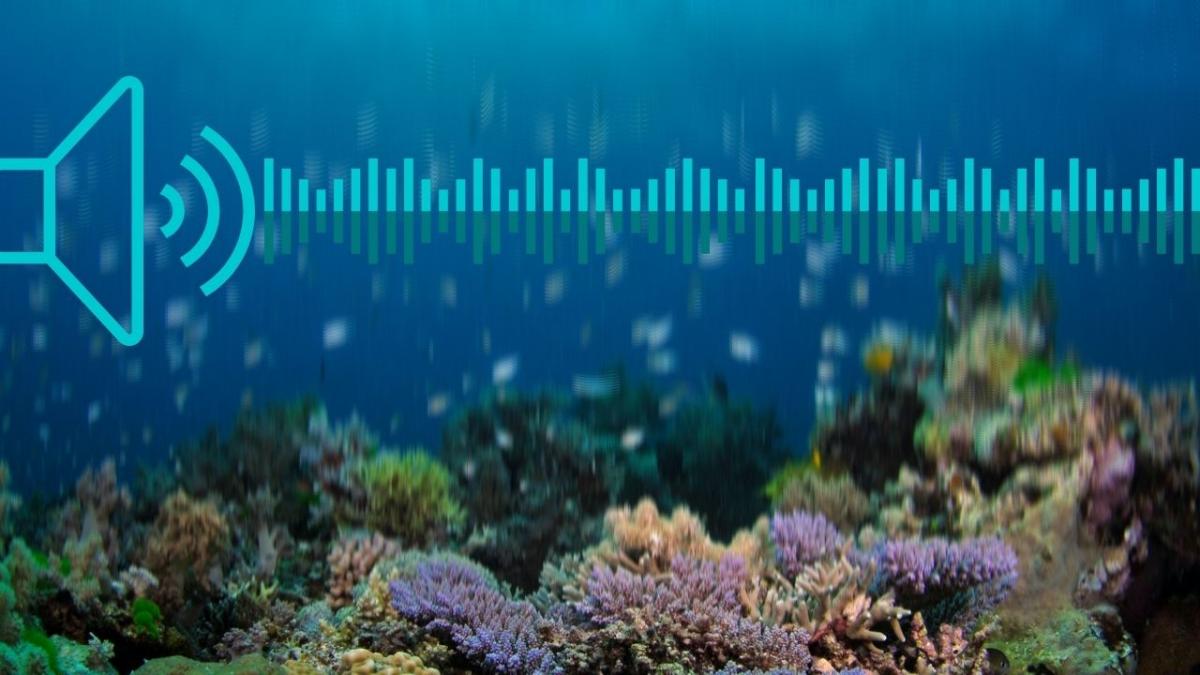
via Australian Institute of Marine Science
By assembling and expanding first-ever global audio collection of aquatic life, scientists aim to unveil unidentified swimming objects, monitor diversity, distribution, abundance, and more
Of the roughly 250,000 known marine species, scientists think all ~126 marine mammals emit sounds – the ‘thwop’, ‘muah’, and ‘boop’s of a humpback whale, for example, or the boing of a minke whale. Audible too are at least 100 invertebrates, 1,000 of the world’s 34,000 known fish species, and likely many thousands more.
Now a team of 17 experts from nine countries has set a goal of gathering on a single platform huge collections of aquatic life’s tell-tale sounds, and expanding it using new enabling technologies – from highly sophisticated ocean hydrophones and artificial intelligence learning systems to phone apps and underwater GoPros used by citizen scientists.
The Global Library of Underwater Biological Sounds, “GLUBS,” will underpin a novel non-invasive, affordable way for scientists to listen in on life in marine, brackish and freshwaters, monitor its changing diversity, distribution and abundance, and identify new species. Using the acoustic properties of underwater soundscapes can also characterize an ecosystem’s type and condition.
The team’s paper, “Sounding the Call for a Global Library of Biological Underwater Sounds,” is published in the journal “Frontiers in Ecology and Evolution.”
Says lead author Miles Parsons of the Australian Institute of Marine Science: “The world’s most extensive habitats are aquatic and they’re rich with sounds produced by a diversity of animals.”
“With biodiversity in decline worldwide and humans relentlessly altering underwater soundscapes, there is a need to document, quantify, and understand the sources of underwater animal sounds before they potentially disappear.”
The team’s proposed web-based, open-access platform will provide:
- A reference library of known and unknown biological sound sources (by integrating and expanding existing libraries around the world);
- A data repository portal for annotated and unannotated audio recordings of single sources and of soundscapes;
- A training platform for artificial intelligence algorithms for signal detection and classification;
- An interface for developing species distribution maps, based on sound; and
- A citizen science-based application so people who love the ocean can participate in this project
The wide range of uses for PAM is expanding in step with advances in technology, providing a large volume of easily-accessible data on aquatic life.
Current uses include:
- Monitoring, characterizing and delineating underwater soundscapes
- Investigating aquatic communities
- Documenting distribution and migration patterns of fish, whales, and other marine mammals
- Characterizing marine life responses to changes in, e.g. temperature, salinity or tides, or changes in behavior and distribution in response to climate change, algal blooms, hurricanes and other extreme weather events
- Understanding how prey change their sound production rates or behaviors in the presence of predators
- Observing how human-caused ocean noise pollution – shipping, resource exploration, construction, aircraft or wind turbines, for example – affect aquatic life communication and other behaviors
Many fish and aquatic invertebrate species are predominantly nocturnal or hard to find, the paper notes, making visual observations difficult or impossible. As a result, “PAM is proving to be one of the most effective ways to monitor visually elusive but vocal species in aquatic environments, which can potentially aid in more effective conservation management,” including zoning in marine park areas or fishery closures, the paper says.
Besides making sounds for communication, many aquatic species produce ‘passive sounds’ while eating, swimming, and crawling – often less acoustically complex or distinct than active sounds but important contributions to an ecosystem’s tell-tale soundscape.
“Collectively there are now many millions of recording hours around the world that could potentially be assessed for a plethora of both known and, to date, unidentified biological sounds.”
Says co-author Aran Mooney of the Wood’s Hole Oceanographic Institution: “Like a biodiverse rainforest, coral reefs are rich with sounds produced by animals as they seek to communicate, defend territories, and attract mates.”
“Biodiversity and our ocean ecosystems are in trouble, with healthy coral reefs declining at alarming rates. This is a problem because reefs provide billions of US dollars in support, in terms of food, protection from storms, and pharmaceutical products. This developing library is a key way to catalog, monitor and track changes in biodiversity on reefs and other ocean habitats before they are gone but also help us define ‘what a healthy reef is’ as we seek to rebuild reefs.”
Adds Jesse Ausubel, a founder of the IQOE and a scientist at The Rockefeller University: “Human song varieties include love and work songs, lullabies, chants, and anthems. Marine animals must sing love songs. Maybe AI applied to the Global Library can help us understand the lyrics of these and many others.”
Original Article: Global Library of Underwater Biological Sounds, “GLUBS,” will help monitor changing marine life
More from: Australian Institute of Marine Science | The Rockefeller University | Woods Hole Oceanographic Institution
The Latest Updates from Bing News & Google News
Go deeper with Bing News on:
Global Library of Underwater Biological Sounds
- Sino Biological finalizes the acquisition of SignalChem Biotech, strengthening global presence and expanding product portfolio
Sino Biological, Inc. ("Sino Biological" or the "Company”), a biotechnology company listed on the Shenzhen stock exchange subsidiary ChiNext, specializing in biological research reagents and ...
- Global Warming of 1.5°C
Taylor, Graeme and Vink, Sue 2021. Managing the risks of missing international climate targets. Climate Risk Management, Vol. 34, Issue. , p. 100379.
- For Media
Each city will receive $100,000 for community-led revitalization projects, as well as dedicated support and training from AmeriCorps VISTA and a team of civic engagement experts from the Bloomberg ...
- Search the United Nations
While there is a growing recognition that biological diversity is a global asset of tremendous value to future generations, the number of species is being significantly reduced by certain human ...
- Treatment.com AI partners with aiXplain Inc. to extend access to its Global Library of Medicine (GLM)
Try refreshing your browser, or tap here to see other videos from our team. Treatment.com AI partners with aiXplain Inc. to extend access to its Global Library of Medicine (GLM) Back to video ...
Go deeper with Google Headlines on:
Global Library of Underwater Biological Sounds
[google_news title=”” keyword=”Global Library of Underwater Biological Sounds” num_posts=”5″ blurb_length=”0″ show_thumb=”left”]
Go deeper with Bing News on:
Biological sound sources
- Research shows baby bird development harmed by sound of cars
A new study by Deakin researchers, published in Science, proves that traffic noise exposure in baby birds directly interferes with their development, which causes severe and long-lasting harm to those ...
- Sino Biological finalizes the acquisition of SignalChem Biotech, strengthening global presence and expanding product portfolio
Sino Biological, Inc. ("Sino Biological" or the "Company”), a biotechnology company listed on the Shenzhen stock exchange subsidiary ChiNext, specializing in biological research reagents and ...
- Invasive species sound off about impending ecosystem changes
Anticipating changes to ecosystems is often at best an educated guess, but what if there was a way to better tune into possible changes occurring? Researchers have discovered that the silent growth of ...
- High Frequency Sound Waves of Small Intensity and their Biological Effects
Mag., 4, 417; September 1927) certain physical and biological effects observed with high frequency sound waves of great intensity. To obtain this great intensity, high potentials (of the order of ...
- I’m a doctor — here’s what to know about rising cancer rates in young people
The researchers examined biological age — a measurement of age ... Halfpoint – stock.adobe.com “These statistics can sound alarming but people need to know that cancer medicine is evolving ...
Go deeper with Google Headlines on:
Biological sound sources
[google_news title=”” keyword=”biological sound sources” num_posts=”5″ blurb_length=”0″ show_thumb=”left”]










